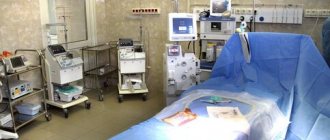Regularly measuring blood sugar at home is a mandatory process for patients with diabetes (regardless of the type of pathology), and the recommended procedure for people:
- with impaired glucose tolerance – a condition characteristic of prediabetes;
- with unstable glycemia (blood sugar levels).
To independently monitor glucose levels, use a portable device - a glucometer. It is customary to measure blood sugar in the laboratory and at home in millimoles per liter (mmol/l).
The need for glycemic control for diabetics
Diabetes mellitus is an irreversible pathology. Once diagnosed, it stays with a person forever. To slow down the development of inevitable complications and maintain a normal quality of life, diabetics must know their sugar levels, follow a diet, constantly take hypoglycemic pills or take insulin injections.
Regular measurements of glucose levels must be recorded in a special “Diabetes Diary”. This will allow:
- assess the dynamics of the disease;
- prevent the development of a diabetic crisis - an emergency condition that threatens coma;
- calculate the required dose of insulin (for type 1 diabetes);
- adjust nutrition and dosage of medications;
- find out the main causes of hyperglycemia (increased blood sugar concentration);
- determine the possible level of physical activity.
Based on systematic indicators, the treating endocrinologist will help predict the course of the disease and minimize the risk of diabetic complications.
An example of filling out a “Diabetes Diary” for type 1 pathology
What does sugar level depend on?
Healthy people need to adhere to a proper diet without overusing foods high in glucose. Patients suffering from diabetes should follow the diet and doctor's recommendations. It is especially important for women to control sugar levels. This is due to their physiological characteristics: elevated glucose values do not always indicate pathology and depend on age and cycle. For example, during menstruation, tests may give inadequate results.
At the age of over 50 years, a change in hormonal levels occurs in the female body, associated with menopause. This is accompanied by changes in carbohydrate metabolism, so women over the age of 60 need to regularly check their blood for sugar.
In pregnant women, the normal blood glucose level is considered to be up to 6.3 mmol/l. If the value increases to 7 mmol/l, additional examination and consultation with a doctor is required.
Blood sugar levels
A key role in the proper absorption of glucose as a source of energy for the body is played by insulin, an intrasecretory hormone of the pancreas that ensures the delivery and distribution of glucose to the tissues and cells of the body. The high-quality work of the pancreas in producing insulin and the full ability of cells to absorb this hormone ensure normal carbohydrate metabolism in the body.
Without diabetes
In the absence of metabolic and hormonal disruptions, the level of fasting glycemia ranges from 3.5 to 5.5 mmol/l. Maximum sugar levels (up to 8.9 mmol/l) are recorded an hour after food enters the stomach, then sugar gradually decreases and is completely normalized after 3 hours.
For optimal assessment of carbohydrate metabolism, measurement is performed 120 minutes after eating. Ideal values do not exceed the accepted norm of 7.8 mmol/l. Minor fluctuations in indicators do not relate to endocrine pathology:
- in women during the perinatal and menopausal periods, which is due to changes in hormonal status;
- after 60 years (regardless of gender), due to an age-related decrease in the sensitivity of body tissues to insulin.
Fasting blood glucose standards by age
For diabetes
In diabetics, the processes of metabolism and production of the hormone insulin are disrupted. In type 1 of the disease, the pancreas does not produce insulin; in type 2, the body's cells refuse to adequately perceive it.
In both cases, glucose synthesized from incoming food accumulates in the blood. In diabetes mellitus, indicators of 4-6 mmol/l before meals, and no more than 8.5 mmol/l after meals, are considered good compensation for the disease.
Acceptable glycemic values for diabetes
| Type 1 (values in mmol/l) | Type 2 (values in mmol/l) | |
| on an empty stomach | 7,8 — 9 | 7,8 – 8,2 |
| +60 min | ≤11,0 | ≤9,0 |
| +120 min | ≤10,0 | 8,5 – 8,9 |
| +180 min | ≤9,0 | ≤7,5 |
Guidelines for diabetics
Indicators by age
Average acceptable blood glucose levels may vary due to a number of factors:
- age;
- general condition of the body;
- diet;
- human lifestyle.
When testing blood from a finger prick on an empty stomach, the following values are acceptable:
- children under 14 years of age - 2.3-3.9 mmol per liter;
- adolescents from 14 to 19 years old - 2.5-4.0 mmol per liter;
- adults 20-49 years old - 3.0-5.5 mmol per liter;
- patients over 50 years old - 3.5-6.5 mmol per liter.
If there are small deviations of a few tenths, this is acceptable.
Frequency of blood sugar measurements in diabetes
The frequency and timing of self-measurements of glucose levels depend on the type of disease. In type 1 diabetes, it is necessary to control sugar several times a day. Diabetics with type 2 are allowed to take measurements 4-7 times a week (while taking glucose-lowering pills and following a diet). Daily monitoring of blood sugar is recommended once every 7-10 days.
Important! The guideline for control should be how you feel. In case of any ailment, a diabetic, first of all, needs to check his blood glucose levels. Timely measurements can prevent the development of a hypoglycemic or hyperglycemic crisis.
Multiplicity of measurements to assess daily dynamics:
- initial morning measurement without leaving bed;
- before breakfast;
- after a morning meal (with an interval of 2 hours);
- before lunch and before dinner;
- after lunch and after dinner (with a 2-hour interval);
- before sports training and other physical activities (including active housework);
- after intense physical activity;
- before falling asleep.
Type 1 diabetics should measure their blood glucose concentration 5 hours after injecting insulin. If you are prone to hypoglycemic risk, it is recommended to carry out control measurements of sugar at night (from 3 to 4 o'clock).
For a patient with diabetes, not only glycemic values that are as close to normal as possible are important, but also the stability of the values. The absence of sugar “spikes” is one of the parameters of good compensation for the disease.
Additionally
Glycemic levels change in women during pregnancy. If you are predisposed to impaired carbohydrate metabolism, the development of gestational diabetes mellitus (GDM) is possible. To avoid complications, expectant mothers suffering from GDM need to monitor their glucose levels in the same way as type 1 diabetics.
Reference values for diabetes that developed during gestation (in mmol/l)
| On empty stomach | One hour interval after eating | 2 hour interval |
| ≤ 5,3 | ≤ 7,8 | ≤ 6,4 |
Blood glucose test
Glucose is an organic compound that is the main source of energy for the body's cells and the only one for the brain and nervous system. For the normal functioning of all organs and systems of the body, a relatively constant level of glucose must be maintained. During digestion, carbohydrate sources are broken down into glucose and other nutrients; they are absorbed by the small intestine and distributed throughout the body. The use of glucose for energy depends on insulin, which facilitates the transport of glucose into the body's cells and stimulates the liver to store excess energy as glycogen for storage.
Typically, blood glucose levels rise slightly after eating, and the pancreas responds by releasing insulin into the blood in an amount appropriate to the size and content of the meal. As glucose enters cells and is metabolized, blood levels drop and the pancreas responds by slowing and then stopping the release of insulin.
About glucometers
The device for measuring blood glucose levels is a portable device equipped with a display and functional buttons. According to the technical characteristics, the following glucometers are used today:
- photometric – indicators are assessed by changes in the color indicator;
- electrochemical - according to current strength;
- non-invasive devices, i.e. without punctures of the skin (thermal, spectral, ultrasound, tonometric).
The latest version of glucometers allows you to avoid permanent injury to the skin and accidental infection of the puncture wound. The disadvantage of this type of device is the high price category. In addition, not all non-invasive models are certified in the Russian Federation. The most common assistant for Russian diabetics is an electrochemical glucometer.
The prerogative aspects of the device include:
Tests for diabetes
- price;
- accuracy (minimum error of results);
- ease of operation;
- high speed of obtaining results;
- auto-encoding of strips (test strips);
- “blood drop” function (0.3 µl is enough to check sugar levels);
- memory function (you can save the results of previous measurements);
- customization function;
- availability of consumables (strips).
Depending on the specific model, the meter may be equipped with additional capabilities for measuring ketone bodies and cholesterol. Popular among diabetics are the functions of calculating the average glycemic value per day (week, month), and automatic connection with a home computer.
Devices differ from each other in color, shape, font size (numbers displayed on the display). Among domestic models, the Satellite Express glucometer (manufactured by Elta, Russia) is considered the leader. The device is distinguished by high accuracy of results and an affordable cost. Equipped with functions:
- auto-on;
- memory;
- uninterrupted use more than 2 thousand times.
Another plus is the Russian-language menu.
The range of possible values for which the device is oriented is 1.8 - 35 mmol/l
The most popular imported devices are glucometers of the AccuChek line (Accu-Chek), manufactured in Switzerland:
- Mobile;
- Assets;
- Performa.
The price of foreign devices is an order of magnitude higher than domestic ones.
Procedure at home
To check blood sugar at home, in addition to the device itself, you need to have a lancet (for puncture), strips, and an alcohol wipe. Mandatory conditions are: test strips match the glucometer model, use of test strips within the expiration date.
Working with a portable device begins with checking the settings. The code number on the display must match the set of numbers on the plate included in the test strip kit. Further actions are performed in the following order:
- remove the strip from the tube and seal the package tightly;
- insert the strip into the device, wait for the image on the display (a drop should appear);
- pierce the skin on the fingertip with a lancet (it is better to choose the side zone);
- remove the released blood with a cotton pad;
- place your finger on the strip when the next drop of blood is released and wait for the result (specific numbers on the display);
- treat the fingertip with an alcohol wipe.
After the procedure, the results and time of measurement must be recorded in the “Diabetes Diary”. Not allowed:
- carry out the procedure with wet hands;
- reuse consumables;
- store strips in an open tube;
- store the device without a trunk (case);
- use strips that do not match the glucometer model.
Failure to follow the rules may lead to distorted results. Detailed instructions for using a glucometer can be obtained during classes at the Diabetes School.
How to measure glucose levels?
To determine the concentration of sugar in the blood, you must:
- wash your hands thoroughly with soap and warm water and wipe dry;
- insert the test strip into the device and turn it on;
- pierce the pad of the middle, index or ring finger, after moving it to speed up blood circulation;
- wipe off the first drop with a cotton swab and apply the second onto the test strip;
- remove and discard the test strip;
- turn off the device.
The result will be known in 5-60 seconds (depending on the model).
To obtain accurate results, you must strictly follow the rules for using the glucometer:
- Before taking measurements, calibrate the device;
- After the puncture, lightly massage your finger without squeezing out the blood;
- Store test strips correctly, observing the expiration date;
- check that the numbers on the test strip packaging correspond to the code on the screen;
- clean the device in a timely manner;
- Change lancets after each blood draw.
Every diabetic should have an individual glucometer. You should not use someone else's device.
The principle of choosing a portable device
Pharmacies offer a wide range of modern glucometers. To ensure that your purchase does not disappoint, before purchasing, it is recommended to monitor online reviews of various models, sites comparing the cost of devices, and manufacturers’ sites with detailed descriptions of the devices.
It would be useful to compare prices in online pharmacies with the cost of glucometers in regular city pharmacies. If in doubt, you can consult your treating endocrinologist. When choosing a device, you should focus on the following parameters:
- the highest possible accuracy of the result;
- availability of consumable strips for constant sale;
- additional functions that will be useful for a particular patient (large font or sound signal for the visually impaired, cholesterol measurement, data transfer to a PC, etc.);
- ease of everyday use;
- price of glucometer and test strips;
- presence of auto-tuning function;
- Possibility of use in hiking conditions, ease of transportation;
- special storage case;
- speed of obtaining results;
- device warranty.
Thanks to the efforts of manufacturers, you can choose the design of the device to your liking.
Results
Checking your glycemic level at home using a glucometer is an integral part of the life of a patient with diabetes. Thanks to this, a diabetic can control his condition, correctly calculate the dose of medication, and take timely measures to prevent critical risks.
The measurement results must be saved to a computer (or recorded) in the “Diabetes Diary”. Analysis of the patient’s records will help the doctor analyze the dynamics and predict the course of endocrine pathology, and, if necessary, adjust treatment tactics.
Against the background of independent measurements, one should not forget about regular visits to the endocrinologist and donating blood in the laboratory. The accuracy of laboratory diagnostics is always higher than that of portable glucometers.
Who needs a glucose tolerance test?
If hyperglycemia is suspected, the doctor prescribes repeat tests. These are tests with a sugar load, allowing you to understand how ready the body is to cope with a one-time supply of glucose in large quantities. This is how the pancreas functions and its ability to produce insulin in large volumes is tested. Tests are carried out after consuming 75 g of glucose dissolved in water. Then the indicators are measured four more times with an interval of half an hour.
During pregnancy, this test is used to diagnose gestational diabetes. A glucose tolerance test is mandatory for all pregnant women at 24-28 weeks. For pregnant women in the risk category (history of gestational diabetes, body mass index more than 30), the test is performed earlier than these dates. It includes two stages of research, which are carried out on an empty stomach and after consuming glucose.









